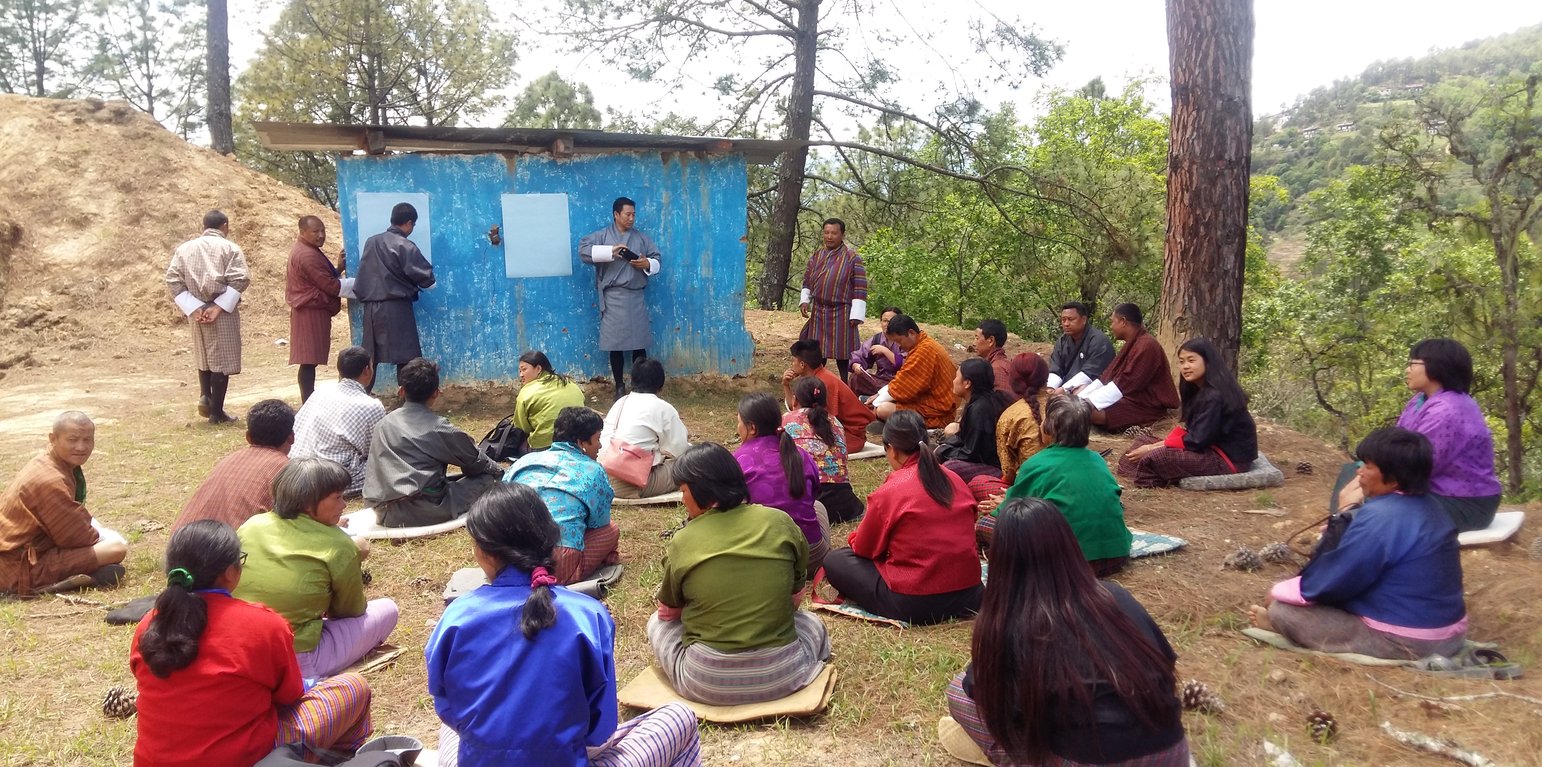Participatory SLM Action Planning
(ບູຕານ)
Yuenten Sazhi Zinchong Gi Chharzhi Tsamni Na Chamar Tokni (ཡུན་བརྟན་ས་གཞི་འཛིན་སྐྱོང་གི་འཆར་གཞི་བཙམ་ནི་ནང་བཅའ་མར་གཏོགས་ནི།)
ຄຳອະທິບາຍ
Participatory SLM action planning is an approach that identifies community-based and land-based issues and challenges, establishes the root causes, and finds out mitigation measures to address the issues for enhancing rural livelihoods.
Participatory SLM Action Planning (SLM AP) is a methodology intended to assess potential SLM interventions in order to address the most severe problems of land degradation. Priorities are determined by identifying the main local issues and their root causes, as well as land-based livelihoods and resources. All community households are included in SLM AP, which is conducted at the chiwog (village) levels. It incorporates Participatory Rural Appraisal (PRA) & Participatory Learning Action (PLA) tools such as natural resource mapping, problem censuses, cropping calendars, history lines, prioritization, ranking and ultimately drawing up a realistic SLM action plan. An external resource person facilitates the discussion while the community decides the final action plan. The process is very interactive and focus group discussions are organized specially for facilitating women’s active participation.
Prior to the SLM action planning exercise, sensitization to available SLM technologies is a must. The sensitization program includes pictorial presentations, relevant SLM audio visuals and displaying of SLM posters. After community sensitization on the first day, the actual SLM action planning exercise is conducted the next day. The participants can discuss with their family members and identify which interventions to incorporate in the plan. The stakeholders involved in the planning exercise consists of community members, local leaders, community civil servants and resource persons. The role of the local leader is to identify interventions that benefits the whole community such as community plantations, landslide stabilization along farm roads, community water source protection and a capacity building program for rural livelihood improvements.
Though this is a holistic bottom-up approach, some of the activities may not qualify for endorsement in the final action plan due to a limited budget and high-cost investments with few beneficiaries. The other drawback is that for every action plan, travel of 3 to 4 days is needed in in every chiwog. In general, the SLM action plan consists of individual household plans and a community SLM plan. Therefore, since every household is included and action plans drawn, land users are satisfied with the approach.
ສະຖານທີ່
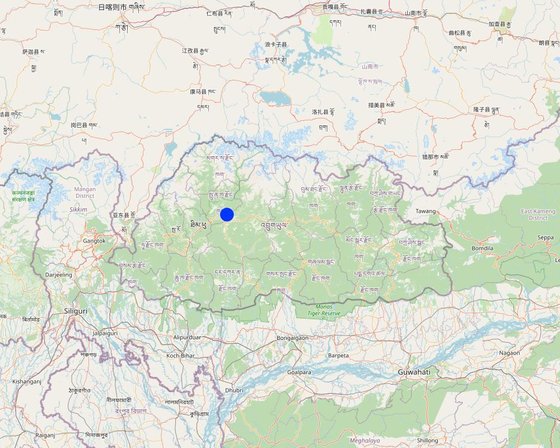
ສະຖານທີ່: Punakha, Nabchey, Lingmukha, Bhutan, ບູຕານ
ການຄັດເລືອກພື້ນທີ່ ທີ່ອີງໃສ່ຂໍ້ມູນທາງພູມີສາດ
ວັນທີເລີ່ມຕົ້ນ: 2020
ປີຂອງການສິ້ນສຸດ: n.a.
ປະເພດຂອງແນວທາງ
-
ພື້ນເມືອງ / ທ້ອງຖີ່ນ
-
ການລິເລີ່ມ ພາຍໃນປະເທດ ທີ່ຜ່ານມາ / ນະວັດຕະກໍາ
-
ພາຍໃຕ້ໂຄງການ / ແຜນງານ
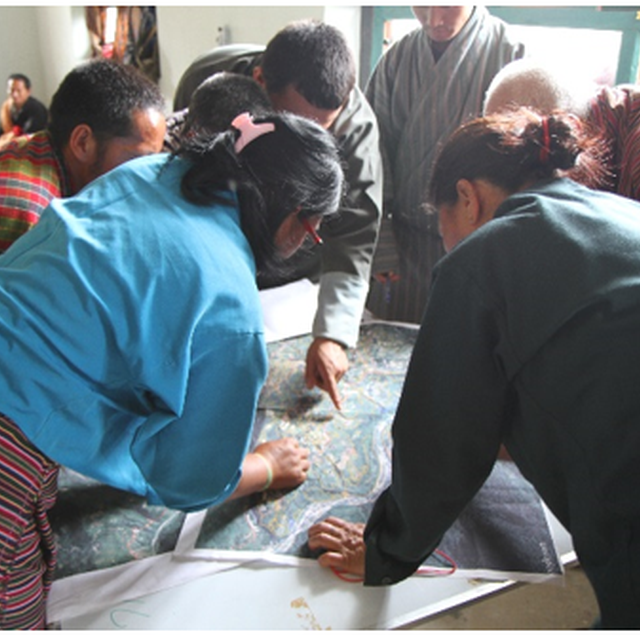
Natural Resource Mapping of the chiwog by the land users using a google earth image (Kuenzang Nima)
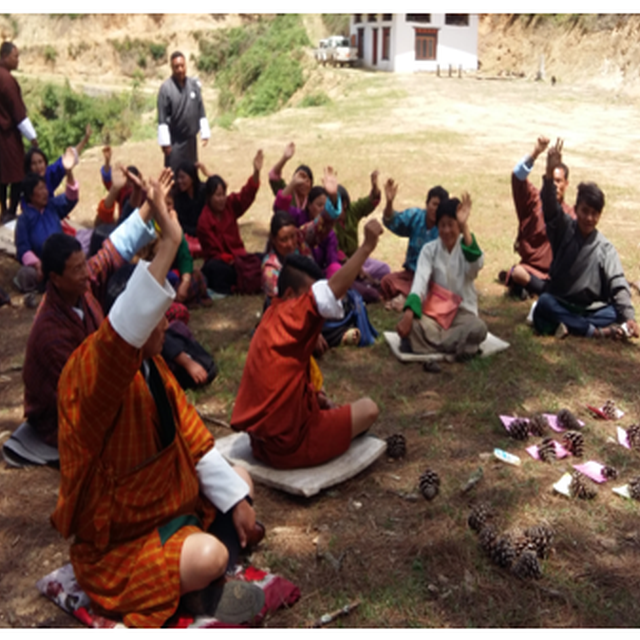
Land users endorsing the identified SLM interventions for incorporation in the final chiwog SLM action plan (Haka Drukpa)
ເປົ້າໝາຍຂອງແນວທາງ ແລະ ການປົກປັກຮັກສາສິ່ງແວດລ້ອມ
ເປົ້າໝາຍ / ຈຸດປະສົງຫຼັກໃນການຈັດຕັ້ງປະຕິບັດແນວທາງ
To assess potential SLM interventions in order to address the most severe problems with land degradation. Priorities are determined by identifying the main local issues and their root causes, as well as land-based livelihoods and resources.
ເງື່ອນໄຂທີ່ສະໜັບສະໜູນໃຫ້ການຈັດຕັ້ງປະຕິບັດເຕັກໂນໂລຢີ ບົນພື້ນຖານແນວທາງ
-
ສັງຄົມ / ວັດທະນະທໍາ / ມາດຕະຖານ ແລະ ຄຸນຄ່າທາງສາສະໜາ: Team building, Cooperation
-
ມີຄວາມສາມາດ / ເຂັ້າເຖິງຊັບພະຍາກອນດ້ານການເງິນ ແລະ ການບໍລິການ: Project support
-
ການຮ່ວມມື / ການປະສານງານຂອງຜູ້ກ່ຽວຂ້ອງ: All the stakeholders including from chiwog levels to Dzongkhag levels are involved in this approach
-
ຄວາມຮູ້ກ່ຽວກັບການຄຸ້ມຄອງ ທີ່ດິນແບບຍືນຍົງ, ການເຂົ້າເຖິງການສະໜັບສະໜູນ ທາງດ້ານວິຊາການ: They are aware of importance of SLM approaches and any related issues regarding the SLM are reported to gewog extension for further technical assistance.
-
ວຽກ, ມີກໍາລັງຄົນ: Households helping each other during their work.
ເງື່ອນໄຂທີ່ເຊື່ອງຊ້ອນໃຫ້ການຈັດຕັ້ງປະຕິບັດເຕັກໂນໂລຢີ ບົນພື້ນຖານແນວທາງ
-
ວຽກ, ມີກໍາລັງຄົນ: Labor shortages from few households
ການມີສ່ວນຮ່ວມ ແລະ ບົດບາດຂອງພາກສ່ວນທີ່ກ່ຽວຂ້ອງທີ່ມີສ່ວນຮ່ວມ
ພາລະບົດບາດຂອງພາກສ່ວນທີ່ກ່ຽວຂ້ອງ ທີ່ມີສ່ວນຮ່ວມໃນການຈັດຕັ້ງປະຕິບັດແນວທາງ
| ແມ່ນໃຜ / ພາກສ່ວນໃດ ທີ່ເປັນເຈົ້າການ ໃນການຈັດຕັ້ງປະຕິບັດ ວິທີການ? |
ລະບຸ ພາກສ່ວນທີ່ກ່ຽວຂ້ອງ |
ພັນລະນາ ບົດບາດ ໜ້າທີ່ ຂອງພາກສ່ວນທີ່ກ່ຽວຂ້ອງ |
| ຜູ້ນໍາໃຊ້ດິນໃນທ້ອງຖິ່ນ / ຊຸມຊົນທ້ອງຖິ່ນ |
land users |
Land users participation in SLM action plan and in program implementation |
| ຜູ້ຊ່ຽວຊານ ການນຄຸ້ມຄອງ ທີ່ດິນແບບຍືນຍົງ / ທີ່ປຶກສາດ້ານກະສິກໍາ |
Department of Agriculture, National Soil Services Center |
Provide technical services, facilitation roles, conducting periodic monitoring and progress reporting |
| ອໍານາດ ການປົກຄອງທ້ອງຖິ່ນ |
RNR extension staffs , Gewog administration staffs & Dzongkhag Agriculture staff |
Program coordination, technical services and timely reporting |
| ພະນັກງານຂັ້ນສູນກາງ (ຜູ້ວາງແຜນ, ຜູ້ສ້າງນະໂຍບາຍ) |
Project management team |
Providing funding support and field monitoring and reporting of project progress |
| ອົງການຈັດຕັ້ງ ສາກົນ |
Green climate fund |
Provide financial support and impact assessment |
ອົງການທີ່ເປັນຕົວແທນໃນການຈັດຕັ້ງປະຕິບັດ
Green climate fund
ການລວບລວມເອົາຜູ້ນໍາໃຊ້ທີ່ດິນໃນທ້ອງຖິ່ນ/ຊຸມຊົນທ້ອງຖິ່ນ ໃນການຈັດຕັ້ງປະຕິບັດແນວທາງ ແຕ່ລະໄລຍະ
ບໍ່ມີ
ການບໍ່ປະຕິບັດ
ການຊ່ວຍເຫຼືອຈາກພາຍນອກ
ການຮ່ວມມື
ການນໍາໃໍຊ້ເອງ
ການເລີ່ມຕົ້ນ / ແຮງຈູງໃຈ
Land users for participation and NSSC for technical support,
ການວາງແຜນ
Land users, Green climate fund, NSSC, local government
ການປະຕິບັດ
Land users, Green climate fund, NSSC, local government
ຕິດຕາມກວດກາ / ການປະເມີນຜົນ
Local government, NSSC, Project Management Unit
ແຜ່ນວາດສະແດງ
Overview of network of stakeholders engaged in SLM action planning.
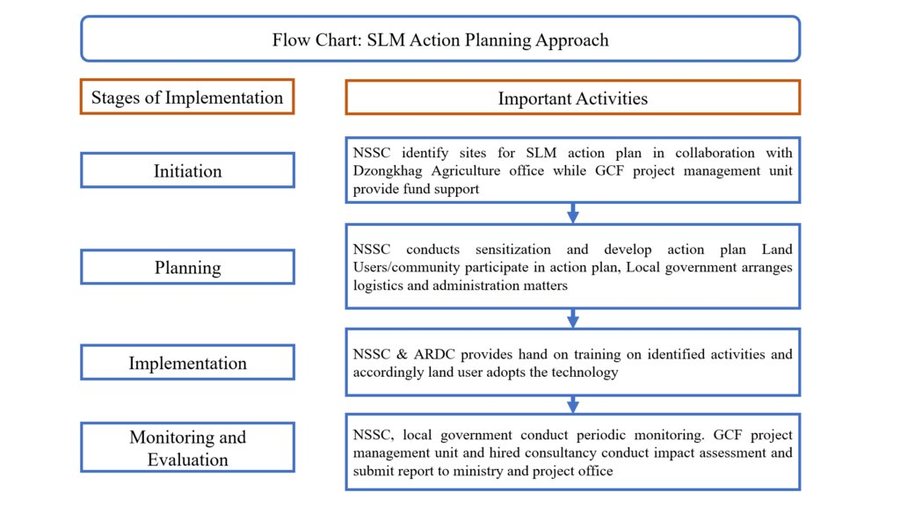
ຜູ້ຂຽນ: Haka Drukpa
ການຕັດສິນໃຈໃນການເລືອກເຕັກໂນໂລຢີ ການຄຸ້ມຄອງທີ່ດິນແບບຍືນຍົງ
ການຕັດສິນໃຈໂດຍ
-
ຜູ້ນໍາໃຊ້ດິນຜູ້ດຽວ (ການລິເລີ່ມດ້ວຍຕົນເອງ)
-
ຜູ້ນໍາໃຊ້ທີ່ດິນຫຼັກ, ການສະໜັບສະໜູນ ໂດຍຜູ້ຊ່ຽວຊານ ການນໍາໃຊ້ທີ່ດິນແບບຍືນຍົງ
-
ພາກສ່ວນກ່ຽວຂ້ອງທັງໝົດ, ເປັນສ່ວນໜຶ່ງ ຂອງວິທີທາງແບບມີສ່ວນຮ່ວມ
-
ຜູ້ຊ່ຽວຊານ ຫຼັກດ້ານການຄຸ້ມຄອງ ທີ່ດິນແບບຍືນຍົງ, ມີການຕິດຕາມປຶກສາຫາລືກັບຜູ້ນໍາໃຊ້ທີ່ດິນ
-
ຊຽ່ວຊານ ສະເພາະດ້ານການຄຸ້ມຄອງ ດິນແບບຍືນຍົງຜູ້ດຽວ
-
ນັກການເມືອງ / ຜູ້ນໍາ
ການຕັດສິນໃຈບົນພື້ນຖານ
-
ປະເມີນເອກກະສານ ຄວາມຮູ້ກ່ຽວກັບ ການຄຸ້ມຄອງ ທີ່ດິນແບບຍືນຍົງ (ຫຼັກຖານທີ່ຊ່ວຍໃນການຕັດສິນໃຈ)
-
ຜົນທີ່ໄດ້ຮັບ ຈາກການຄົ້ນຄວ້າ
-
ປະສົບການສ່ວນບຸກຄົນ ແລະ ຄວາມຄິດເຫັນ (ທີ່ບໍ່ເປັນເອກກະສານ)
ການສະໜັບສະໜູນເຕັກໂນໂລຢີ, ການສ້າງຄວາມອາດສາມາດ ແລະ ການຄຸ້ມຄອງຄວາມຮູ້
ກິດຈະກຳ ດັ່ງລຸ່ມນີ້ ແມ່ນເປັນພາກໜຶ່ງຂອງແນວທາງ
-
ການສ້າງຄວາມສາມາດ / ການຝຶກອົບຮົມ
-
ການບໍລິການໃຫ້ຄໍາປຶກສາ
-
ສະຖາບັນການສ້າງຄວາມເຂັ້ມແຂງ (ການພັດທະນາອົງການຈັດຕັ້ງ)
-
ຕິດຕາມກວດກາ ແລະ ປະເມີນຜົນ
-
ການຄົ້ນຄວ້າ
ການສ້າງຄວາມອາດສາມາດ / ຝຶກອົບຮົມ
ໄດ້ສະໜັບສະໜູນຝຶກອົບຮົມໃຫ້ແກ່ພາກສ່ວນກ່ຽວຂ້ອງດັ່ງລຸ່ມນີ້
-
ຜູ້ນໍາໃຊ້ດິນ
-
ພະນັກງານພາກສະໜາມ / ທີ່ປຶກສາ
ຮູບແບບການຝຶກອົບຮົມ
-
ການເຮັດຕົວຈິງ
-
ຕົວຕໍ່ຕົວ
-
ເນື້ອທີ່ສວນທົດລອງ
-
ກອງປະຊຸມ
-
ຫຼັກສູດ
ກວມເອົາຫົວຂໍ້
The training consists of in house sensitization and practical demonstration in field. The training topics covers wide range including SLM technologies, Climate resilient practices, group formation for water user association and improved livestock management techniques
ການບໍລິການທາງດ້ານການໃຫ້ຄໍາປຶກສາ
ໄດ້ຮັບການບໍລິການທາງດ້ານການໃຫ້ຄໍາປຶກສາ
-
ໃນພື້ນທີ່ຂອງຜູ້ນໍາໃຊ້ດິນ
-
ສູນຄົ້ນຄວ້າ
-
Extension office
Technical services were provided in the field as well as in meetings.
ຄວາມເຂັ້ມແຂງຂອງສະຖາບັນ
ສະຖາບັນ ໄດ້ຮັບການສ້າງຄວາມເຂັ້ມແຂງ
-
ບໍ່ມີ
-
ມີ, ໜ້ອຍໜຶ່ງ
-
ມີ, ພໍສົມຄວນ
-
ມີ, ຫຼາຍ
ໃນລະດັບດັ່ງລຸ່ມນີ້
-
ທ້ອງຖິ່ນ
-
ລະດັບພາກພື້ນ
-
ແຫ່ງຊາດ
ອະທິບາຍສະຖາບັນ, ພາລະບົດບາດແລະຄວາມຮັບຜິດຊອບ, ສະມາຊິກ, ແລະອື່ນໆ.
Informal labor sharing group were instituted facilitated by gewog extension officers to speed up the implementation of activities especially benefitting whole community such as water user group.
ຮູບແບບການສະໜັບສະໜູນ
-
ທາງດ້ານການເງິນ
-
ການສ້າງຄວາມອາດສາມາດ / ການຝຶກອົບຮົມ
-
ອຸປະກອນ
ລາຍລະອຽດເພີ່ມເຕີມ
Funds were provided by the project office on annual workplan basis. Technical assistance provided by NSSC/ARDC/Dzongkhag
ການຕິດຕາມ ແລະ ປະເມີນຜົນ
Periodic monitoring was conducted by Project management Unit, NSSC, Dzongkhag while evaluation were carried out by private consultancy firms deputed by GCF project head office
ການສະໜັບສະໜູນທາງດ້ານການເງິນ ແລະ ອຸປະກອນຈາກພາຍນອກ
ງົບປະມານປະຈຳປີ ໃນກິດຈະກຳ ການຄຸ້ມຄອງທີ່ດິນແບບຍືນຍົງ ທີ່ເປັນສະກຸນເງິນໂດລາ
-
< 2,000
-
2,000-10,000
-
10,000-100,000
-
100,000-1,000,000
-
> 1,000,000
Precise annual budget: n.a.
This budget is for Punakha, Nabchey, Lingmukha funded by Green climate fund
ການບໍລິການ ຫຼື ສິ່ງກະຕຸກຊຸກຍູ້ ດັ່ງລຸ່ມນີ້ ແມ່ນໄດ້ສະໜອງໂດຍຜູ້ນຳໃຊ້ທີ່ດິນເອງ
-
ການສະໜັບສະໜູນ ທາງດ້ານການເງິນ / ອຸປະກອນ ສະໜອງໃຫ້ແກ່ຜູ້ນໍາທີ່ດິນ
-
ຫຼຸດປັດໃຈນໍາເຂົ້າ
-
ສິນເຊື່ອ
-
ສິ່ງຈູງໃຈ ຫຼື ເຄື່ອງມືອື່ນໆ
ເງິນສະໜັບສະໜູນອຸປະກອນ / ສະໜອງໃຫ້ຜູ້ຊົມໃຊ້ທີ່ດິນ
Financial support by Green climate fund on SLM technologies 1) Contour stone bunds construction : USD 61.00/per acre 2) Hedgerows: USD 85/acre, 3) Machine terracing: USD 854/acre, 4) Small (1-2 meter wide and depth) Check-dams construction: USD 18/dam .
ງົບປະມານບາງສ່ວນ
ງົບປະມານເຕັມສ່ວນ
ອຸປະກອນ: ເຄື່ອງກົນຈັກ
Machines for bench terracing
ອຸປະກອນ: ເຄື່ອງກົນຈັກ: ເຄື່ອງມື
Cost sharing (80% by Project, 20% by land user) Green house,
fuel
fueling of government machines for terracing
ກະສິກໍາ: ແນວພັນ, ແກ່ນພັນ
Horticulture seeds and seedlings
ກະສິກໍາ: ແນວພັນ, ແກ່ນພັນ: ຝຸ່ນ, ປຸ໋ຍ
ການກໍ່ສ້າງ: ຫີນ
stone check-dams (45% by project and 55% by land users
ແຮງງານຂອງຜູ້ນໍ້າໃຊ້ທີ່ດິນ
-
ການອາສາ
-
ລ້ຽງເຂົ້າ - ອາຫານ
-
ຈ່າຍເປັນເງິນສົດ
-
ໄດ້ຮັບການສະໜັບສະໜູນ ອຸປະກອນດ້ານອື່ນ
ການວິເຄາະຜົນກະທົບ ແລະ ສະຫຼຸບລວມ
ຜົນກະທົບຂອງການນໍາໃຊ້ແນວທາງ
ບໍ່
ມີ, ໜ້ອຍໜຶ່ງ
ມີ, ພໍສົມຄວນ
ມີ, ຫຼາຍ
ວິທີທາງ ຊ່ວຍຊຸກຍູ້ ຜູ້ນຳໃຊ້ທີ່ດິນທ້ອງຖີ່ນ, ໃນການປັບປຸງ ການມີສ່ວນຮ່ວມ ຂອງຜູ້ທີ່ກ່ຽວຂ້ອງ ບໍ່?
The decisions were made by the land users and the approach was well received.
ການນໍາໃຊ້ ວິທີທາງ ດັ່ງກ່າວນີ້ ສາມາດເປັນຫຼັກຖານ ທີ່ສະໜັບສະໜູນ ໃຫ້ການຕັດສິນໃຈໄດ້ບໍ່?
Land users were taken for short study visits to successful SLM sites where by decision made was supported by evidence based observation.
ການຈັດຕັ້ງປະຕິບັດ ວິທີທາງ ສາມາດຊ່ວຍຜູ້ນໍາໃຊ້ທີ່ດິນ ໃນການຈັດຕັ້ງປະຕິບັດ ແລະ ບໍາລຸງຮັກສາ ເຕັກໂນໂລຢີ ການຄຸ້ມຄອງ ທີ່ດິນແບບຍືນຍົງໄດ້ບໍ?
Yes, they still practice and maintain the SLM technologies implemented in their field, however, since SLM interventions were of long term return investment requiring high labor, the adoption rate still remains moderate.
ການນໍາໃຊ້ ວິທີທາງ ສາມາດປັບປຸງຄວາມຮູ້ ແລະ ຄວາມສາມາດຂອງຜູ້ນໍາໃຊ້ທີ່ດິນ ໃນການປະຕິບັດ ການຄຸ້ມຄອງ ທີ່ດິນແບບຍືດຍົງໄດ້ບໍ່?
Land users were trained on various technologies and advantages and some progressive farmers were scaling up at larger scale.
ການຈັດຕັ້ງປະຕິບັດ ວິທີທາງ ສາມາດສ້າງຄວາມເຂັ້ມແຂງ ທາງສັງຄົມ ແລະ ເສດຖະກິດບໍ່?
As all the financial needs were fulfilled by GCF,
ການຈັດຕັ້ງປະຕິບັດ ວິທີທາງ ສາມາດປັບປຸງ ຄວາມສະເໜີພາບ ຂອງບົດບາດ ຍິງຊາຍ ແລະ ສ້າງຄວາມເຂັ້ມແຂງໃຫ້ຜູ້ຍິງໄດ້ບໍ່?
Women were equally given opportunity to participate in planning and training program.
ການຈັດຕັ້ງປະຕິບັດ ວິທີທາງ ສາມາດຊຸກຍູ້ ຜູ້ນໍາໃຊ້ທີ່ດິນທີ່ເປັນຊາວໜຸ່ມ / ຄົນລຸ້ນໃໝ່ ໃນການຄຸ້ມຄອງ ທີ່ດິນແບບຍືນຍົງໄດ້ບໍ?
Younger generations were facilitated to take up high tech technologies such as hydroponic, mega green house, drip irrigation and even supported with farm machineries power tillers on cost sharing basis.
ການຈັດຕັ້ງປະຕິບັດ ວິທີທາງ ສາມາດປັບປຸງ ປະເດັນການຖືຄອງທີ່ດິນ / ສິດທິໃນການນໍາໃຊ້ທີ່ດິນ ທີ່ເຊື່ອງຊ້ອນໃນການຈັດຕັ້ງປະຕິບັດ ເຕັກໂນໂລຢີ ການຄຸ້ມຄອງ ທີ່ດິນແບບຍືນຍົງໄດ້ບໍ?
Vulnerable agriculture farm lands were brought under SLM
ການນໍາໃຊ້ ວິທີທາງ ໄດ້ປັບປຸງ ການຄໍ້າປະກັນສະບຽງອາຫານ ຫຼື ປັບປຸງໂຄສະນາການໄດ້ບໍ່?
Since vulnerable farm lands were brought under SLM, farmers were able to use farm machines, adopt new techniques which facilitated in improving food security and better nutritional up take.
ການນໍາໃຊ້ ວິທີທາງ ໄດ້ປັບປຸງ ການເຂົ້າເຖິງນໍ້າ ແລະ ສາຂາພິບານໄດ້ບໍ່?
Improved irrigation water supplies to the farm land
ການຈັດຕັ້ງປະຕິບັດ ວິທີທາງ ສາມາດສ້າງຄວາມອາດສາມາດໃຫ້ຜູ້ນໍາໃຊ້ດິນ ໃນການປັບຕົວ ຕໍ່ການປ່ຽນແປງດິນຟ້າອາກາດ / ຫຼດຜ່ອນຄວາມສ່ຽງທາງໄພພິບັດໄດ້ບໍ?
Since land degradation and Climate change were two side of same coin, the approach had educated the land users on impacts of climate change and accordingly adapt and build resilience.
ການນໍາໃຊ້ ວິທີທາງ ໄດ້ປັບປຸງ ການຈ້າງງານ, ໂອກາດ ໃນການສ້າງລາຍຮັບບໍ່?
Few school drop outs were able to start a farm enterprise and were able to generate cash income and employment ( vegetable production)
ສິ່ງກະຕຸກຊຸກຍູ້ໃຫ້ຜູ້ນໍາໃຊ້ທີ່ດິນ ໃນການປະຕິບັດການຄຸ້ມຄອງທີ່ດິນແບບຍືນຍົງ
-
ການຜະລິດເພີ່ມຂຶ້ນ
-
ກໍາໄລເພີ່ມຂຶ້ນ (ຄວາມສາມາດ), ການປັບປຸງຄ່າໃຊ້ຈ່າຍ, ຜົນປະໂຫຍດ, ອັດຕາສ່ວນ
-
ຫຼຸດຜ່ອນດິນເຊື່ອມໂຊມ
-
ຫຼຸດຜ່ອນຄວາມສ່ຽງຂອງໄພພິບັດ
-
ການຫຼຸດຜ່ອນພາລະວຽກ
-
ການຊໍາລະເງິນ / ເງິນອຸດໜູນ
-
ກົດລະບຽບແລະລະບຽບການ (ລະອຽດ) / ການບັງຄັບໃຊ້
-
ກຽດສັກສີ, ຄວາມກົດດັນທາງສັງຄົມ / ການຕິດຕໍ່ກັນທາງສັງຄົມ
-
ລວມເຂົ້ານໍາກັນກັບການເຄື່ອນໄຫວ / ໂຄງການ / ກຸ່ມ / ເຄືອຂ່າຍ
-
ຄວາມຮັບຮູ້ ທາງສີ່ງແວດລ້ອມ
-
ພາສີ ແລະ ຄວາມເຊື່ອຖື, ສົມບັດສິນທໍາ
-
ການປັບປຸງ ຄວາມຮູ້ ແລະ ຄວາມສາມາດ ຂອງການຄຸ້ມຄອງ ທີ່ດິນແບບຍືນຍົງ
-
ການປັບປຸງຄວາມງົດງາມ
-
ການຫຼຸດຜ່ອນຂໍ້ຂັດແຍ່ງ
ຄວາມຍືນຍົງຂອງການຈັດຕັ້ງປະຕິບັດກິດຈະກໍາຂອງແນວທາງ
ຜູ້ນໍາໃຊ້ທີ່ດິນ ສາມາດຈັດຕັ້ງປະຕິບັດຕາມແນວທາງໄດ້ເອງບໍ່ (ໂດຍປາດສະຈາກການສະໜັບສະໜູນຈາກພາກສ່ວນພາຍນອກ)?
Most of the SLM interventions were of one time investment and maintenance cost were very minimum. The land users will be able to take care and incase of major issues, the funds will be supported by the local government for maintenance such as irrigation channel renovation.
ບົດສະຫຼຸບ ແລະ ບົດຮຽນທີ່ໄດ້ຮັບ
ຄວາມເຂັ້ມແຂງ: ທັດສະນະມູມມອງ ຂອງຜູ້ນໍາໃຊ້ທີ່ດິນ
-
The Participatory SLM planning approach is basically putting the farmers first and farmers last. Since the plan is developed by land users, they take full ownership which ensures sustainability of the program.
-
Improved social interaction and cohesion
-
Opportunity for mass sensitization on SLM and climate change to the land users
ຄວາມເຂັ້ມແຂງ: ທັດສະນະມຸມມອງ ຂອງຜູ້ປ້ອນຂໍ້ມູນເອງ
-
Best approach in empowering rural land users.
-
Experts needed to facilitate only
-
Ensures sustainability and successful program implementation
ຈຸດອ່ອນ / ຂໍ້ເສຍ / ຄວາມສ່ຽງ: ທັດສະນະມູມມອງ ຂອງຜູ້ນໍາໃຊ້ທີ່ດິນວິທີການແກ້ໄຂແນວໃດ
-
Expertise and knowledge gap
consult SLM specialist
-
Elite land users dominating the decision making power
Give equal opportunity to all actors in decision making.
-
Poor participation or un-responsive participants during meetings
Meeting to be attended by head of the household or one who can decide and have decision making power.
ຈຸດອ່ອນ / ຂໍ້ເສຍ / ຄວາມສ່ຽງ: ທັດສະນະມຸມມອງ ຂອງຜູ້ປ້ອນຂໍ້ມູນເອງວິທີການແກ້ໄຂແນວໃດ
-
Difficult to fulfill all demands enlisted in the action plan ( ambitious plan). Some interventions are outside project scope while its of utmost importance to the community such as farm road construction, human wildlife conflicts and new irrigation channel construction requiring high investment.
Sensitization on Project scope, its intended supports and forward the outside project activities to the local government for sourcing funds.
-
Taking program at chiwog level is time consuming and its resource intensive.
Systematic planning and proper budget from initial phase
-
Some land users takes opportunity of the project support though its not much important to them ( free inputs).
Periodic monitoring to ensure the proper utilization.
ເອກກະສານອ້າງອີງ
ການທົບທວນຄືນ
-
William Critchley
-
Rima Mekdaschi Studer
-
Joana Eichenberger
ວັນທີຂອງການປະຕິບັດ: July 5, 2023
ປັບປຸງລ່າສຸດ: June 4, 2024
ບຸກຄົນທີ່ສໍາຄັນ
-
Tashi Dorji Drukpa - ຜູ້ນໍາໃຊ້ທີ່ດິນ
-
Sonam Jigme - ຜູ້ນໍາໃຊ້ທີ່ດິນ
-
Sonam Dendrup - ຜູ້ນໍາໃຊ້ທີ່ດິນ
-
Namgay Wangmo - ຜູ້ນໍາໃຊ້ທີ່ດິນ
-
Kinga Zangmo - ຜູ້ນໍາໃຊ້ທີ່ດິນ
ການບັນຍາຍລາຍລະອຽດ ໃນຖານຂໍ້ມູນ ຂອງ WOCAT
ຂໍ້ມູນການເຊື່ອມໂຍງຂໍ້ມູນການຄຸ້ມຄອງການນໍາໃຊ້ດິນແບບຍືນຍົງ
ເອກກະສານ ແມ່ນໄດ້ອໍານວຍຄວາມສະດວກໂດຍ
ສະຖາບັນ
ໂຄງການ
- Strengthening national-level institutional and professional capacities of country Parties towards enhanced UNCCD monitoring and reporting – GEF 7 EA Umbrella II (GEF 7 UNCCD Enabling Activities_Umbrella II)
ການອ້າງອີງທີ່ສໍາຄັນ
-
NSSC Bhutan catalogue of soil and water conservation approaches and technologies, 2012: National Soil Service Center, Department of Agriculture, Ministry of Agriculture and Livestock, RGOB.
-
Agriculture land development guidelines (17th June 2017): National Soil Service Center, Department of Agriculture, Ministry of Agriculture and Livestock, RGOB.
ເຊື່ອມໂຍງກັບ ຂໍ້ມູນຕ່າງໆ ທີ່ກ່ຽວຂ້ອງທີ່ມີ
